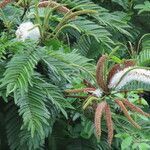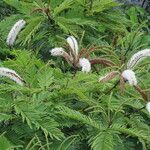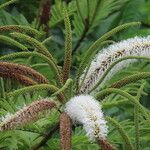Unarmed tree, the branchlets stout, longitudinally striate, puberulent when young, callous in age. Leaves very large, bipinnate, the pinnae many (usually 15-20) pairs, opposite, the leaflets many pairs per pinna; petiole 1-5 cm. long, eglandular, terete except shallowly sulcate above, callous basally; rachis as much as 3 dm. long, pubescent above, eglandular; pinnae 2-10 cm. long, eglandular; leaflets small, linear-subfalcate, mostly 6-9 mm. long and 1-2 mm. wide, sharply acute-acuminate apically, obliquely rounded or truncate and more-or less auricu-late on the proximal side basally, essentially glabrous, darker and lustrous above, the venation fairly prominent below; stipules small, linear. Inflorescence of few or several terminal and subterminal, elongate spikes; peduncular portion of spike 1-5 cm. long, pubescent; floriferous portion usually 15 or more cm. long at maturity, pubescent, ebracteate. Flowers dense, sessile, 5-parted, white; calyx cupulate, 1-2 mm. long, the broad, rounded lobes shorter than the tube and some-what imbricate in bud; petals linear-elliptic, about 5 mm. long, usually coherent for about the lower third or half of their length, glabrous, valvate; stamens 5, 6-7 mm. long, alternating with 5 thin, elongate staminodia about 2 cm. long, stamens and staminodia briefly united at the base; anthers about 1 mm. long, bearing a prominent apical gland or appendage; ovary subsessile, pubescent; style slightly exceeding the stamens; stigma expanded. Legume linear-subspatulate, 2-3 dim. long and up to 4 cm. wide, flattened but thick, ligneous, narrowed baseward, lustrous, glabrous, longitudinally striate, 2-valvate, the valves coiling backwards after dehiscence.
More
A tree. It grows 40 m tall. The trunk can be 1.3 m across. The bark is smooth and grey-brown. The leaves are twice divided. They are 30 cm long. There are many small leaflets along the stalk. The flowers are small and crowded in groups 15-20 cm long. The fruit is a pod that splits open. It is 20-50 cm long by 4-6 cm wide. There are 3-8 seeds in each pod.




